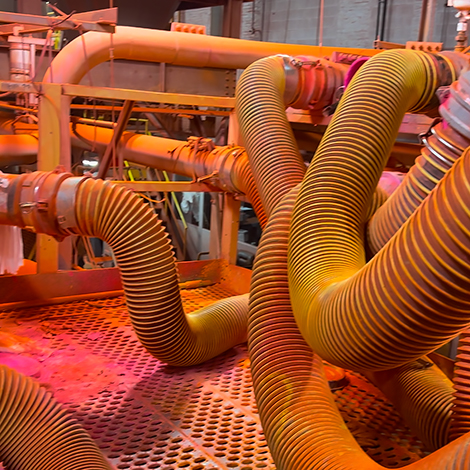Standing in Public Square, it’s hard not to gape at the latest addition to Cleveland’s skyline, particularly as the summer sun’s rays illuminate its glass exterior — Sherwin-Williams’ latest corporate headquarters, a 616-foot-tall skyscraper on West Sixth Street, is a site to behold. But look to the street level and you’ll find, hiding very loudly in plain sight, the signatures of another local icon of the industry — in bright orange traffic cones and highlighter-yellow safety vests.
This year, DayGlo Color Corp., located at 4515 St. Clair Ave., celebrates its 90th anniversary since brothers Bob and Joe Switzer founded the company as Fluor-S-Art Co. in 1934. The Switzers pioneered fluorescent paints and pigments,
forever changing the worlds of advertising, fashion and safety.
DayGlo is one in a colorful corps of paint and coatings companies long headquartered locally. Along with Sherwin-Williams, Glidden and RPM International, which acquired DayGlo in 1991, this quartet of manufacturers has built Ohio’s reputation as a national leader in the industry. According to research from the American Coatings Association, Ohio ranked fifth in paint and coatings employment with 13,362 jobs in 2019, producing the third-highest exports ($188 million) in 2020.
“You’ve got a situation where the Midwest is just a powerhouse of manufacturing, so a lot of the chemical industry has grown up and evolved [here],” says Will Wooten, DayGlo’s vice president of global sales and marketing. “It well positions Ohio, and Cleveland in particular, to source materials to make paints or pigments.”
Suggested: Orlando Bread Co. Celebrates 150 Years in Business
All it takes is one glimpse of DayGlo’s revolutionary pigment, the raw powder added in the manufacturing process to create products that are vibrantly fluorescent, to see why it has found lasting success as a standout in a crowded local industry.
After Bob Switzer sustained an injury in 1933 while working at a tomato quality control laboratory in California, he was inspired to explore the prospects of fluorescence while recovering his eyesight in a dark room. DayGlo’s original style was innovated through an accidental discovery, after dipping silk in a combination of fluorescent dye and alcohol. With sights set on advertisement, the Switzers moved their small operation cross-country in the late 1930s to partner with Cleveland’s Continental Lithograph, a company that produced movie posters for Warner Brothers Pictures.

(Jacob DeSmit)
Over nearly a century, the company would widely expand its business ventures, coloring psychedelic and neon fashions, coating American warships for increased visibility during World War II and helping to establish brand identities popular in American culture. Without DayGlo pigments, Tide detergent’s orange bottle, the album cover of Cream’s Disraeli Gears, or, in more recent years, some styles of Reebok’s “Zoku Runner” shoe, don’t look so vivid and eye-catching.
Today, DayGlo’s local operation spans three facilities, in Cleveland, Twinsburg and Avon, employing more than 150 workers. As the company is the only remaining fluorescent pigment manufacturer in the United States, these compounds make up much of its modern business, though separate buildings near its primary headquarters are used for paint, dye and polymer production.
Vice president of research and development Tom DiPietro, with DayGlo since 1987, has observed the company’s popularity wax and wane over the course of his career. Noting the enormous popularity of neon clothing when he joined in the late 1980s, he says the colors DayGlo’s pigments produce trends in and out.
“In 2015 and ’16, [the popularity] seemed to be from sports shoes and apparel,” says DiPietro. “It sort of tailed off, but it comes and goes. We have core packaging that does not do that, but when those fashion booms come, it drags everything else, so we get really busy.”
Touring DayGlo’s Cleveland facility feels like stepping into a sci-fi spaceship after an intergalactic battle — splatters of fluorescent yellow, orange and pink cover just about every surface, dripping like alien guts or covering the industrial machinery in a thin layer of colorful dust. Over the course of three floors, pigment creation begins as a taffy-like mixture of dyes and formaldehyde, which is cooled into vibrant shards like glass before being crushed to the powdery substance that is bagged for distribution.
As the company continues to evolve, it seeks processes to make its products and production methods safer and more environmentally friendly. According to research chemist William Storms-Miller, with DayGlo since 2021, this could include finding ways to move away from solvent-borne coatings to water-borne compounds, in order to eliminate the use of volatile organic compounds.
“The push within the industry is in How can we get rid of the use of solvent? and How can we push toward more bio-derived content? as we accept that peak oil will happen and the petro-chemical industry is going to change,” says Storms-Miller. “How can the paint industry react to that proactively?”
For more updates about Cleveland, sign up for our Cleveland Magazine Daily newsletter, delivered to your inbox six times a week.
Cleveland Magazine is also available in print, publishing 12 times a year with immersive features, helpful guides and beautiful photography and design.

.jpg?sfvrsn=f968f78c_1&w=475&auto=compress%2cformat)


